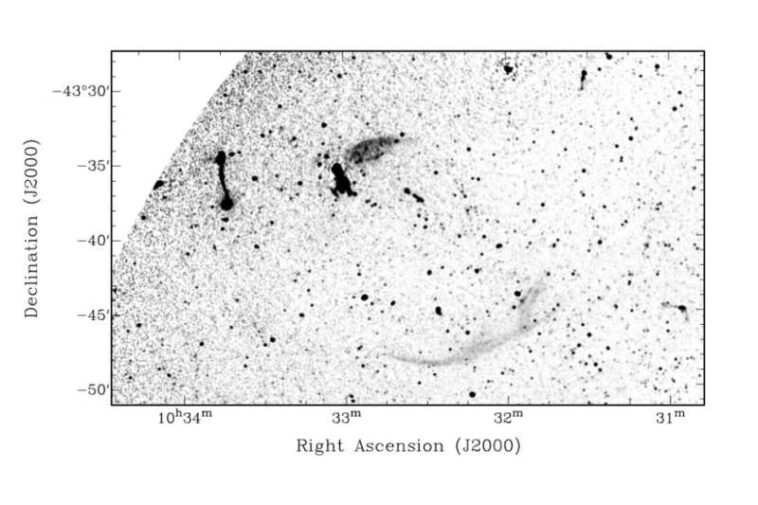
MeerKAT 1.3 GHz radio continuum image of a newly discovered binary relic associated with galaxy cluster PSZ2 G277.93+12.34. Photo credit: Koribalski et al., 2023
Observing the merging galaxy cluster PSZ2 G277.93+12.34 with the MeerKAT radio telescope, an international team of astronomers has accidentally discovered a double radio relic and a strange radio circle. The discovery was detailed in a paper published April 24 arXiv Pre-Print Repository.
Radio relics are diffuse, elongated radio sources of synchrotronic origin. They appear in the form of spectacular single- or double-symmetric arcs at the periphery of galaxy clusters. Astronomers are particularly interested in finding duplicate relics, as such features could provide crucial information about cluster mergers and the resulting emission.
At a distance of about 2.5 billion light-years from Earth, PSZ2 G277.93+12.34 is a galaxy cluster with a mass of about 360 trillion solar masses. The cluster is poorly studied, so its members are currently not well defined. However, previous observations have indicated that a galaxy named WISEA J103230.00–433815.4 is most likely the brightest cluster galaxy of PSZ2 G277.93+12.34.
A team of astronomers led by Bärbel S. Koribalski of Western Sydney University in Australia recently used MeerKAT to probe PSZ2 G277.93+12.34 to shed more light on the nature of this cluster. Their study was complemented by radio continuum images from Australia’s SKA Pathfinder (ASKAP) and X-ray data from the Spectrum-Roentgen-Gamma (SRG) space telescope.
By analyzing MeerKAT 1.3 GHz radio continuum images of PSZ2 G277.93+12.34, researchers discovered two large radio relics located northeast and southwest of the cluster center and a double radio relic angularly separated by about 16 arc minutes (about 8, 5 million light years). The southern relic is relatively thin, has a linear extent of about 5.35 million light-years, and a surface magnitude of about 16 𝜇Jy/ray. The northern relic is twice as wide as the southern one, has a linear extent of at least 2.15 million light-years, and its surface brightness has been measured at 55 𝜇Jy/ray.
The two relics together have been found to form a partial circle that occupies at least 35% of its circumference. According to the authors of the article, the double relic morphology suggests a frontal orientation of the fusion; However, to verify this, low-frequency imaging of the PSZ2 G277.93 + 12.34 with high resolution and high sensitivity is required.
In addition to discovering the double radio relic, astronomers also discovered a new odd radio circle (ORC) at a redshift of about 0.3 in another part of the MeerKAT images. The so-called ORCs are mysterious gigantic rings of radio waves and their origin is still unclear.
The newly discovered ORC, designated ORC J1017-4422, remains undetected in X-ray emission and is about 1.3 million light-years across. It is the fourth single ORC identified to date.
More information:
Bärbel S. Koribalski et al, MeerKAT discovery of a double radio relic and an odd radio circle, arXiv (2023). DOI: 10.48550/arxiv.2304.11784
Journal Information:
arXiv
© 2023 Science X Network
Citation: Double Radio Relic and Odd Radio Circle discovered with MeerKAT (2023, May 2), retrieved May 2, 2023 from https://phys.org/news/2023-05-radio-relic-odd-circle-meerkat .html
This document is protected by copyright. Except for fair trade for the purpose of private study or research, no part may be reproduced without written permission. The content is for informational purposes only.
#Duplicate #radio #relic #strange #radio #circle #discovered #MeerKAT





